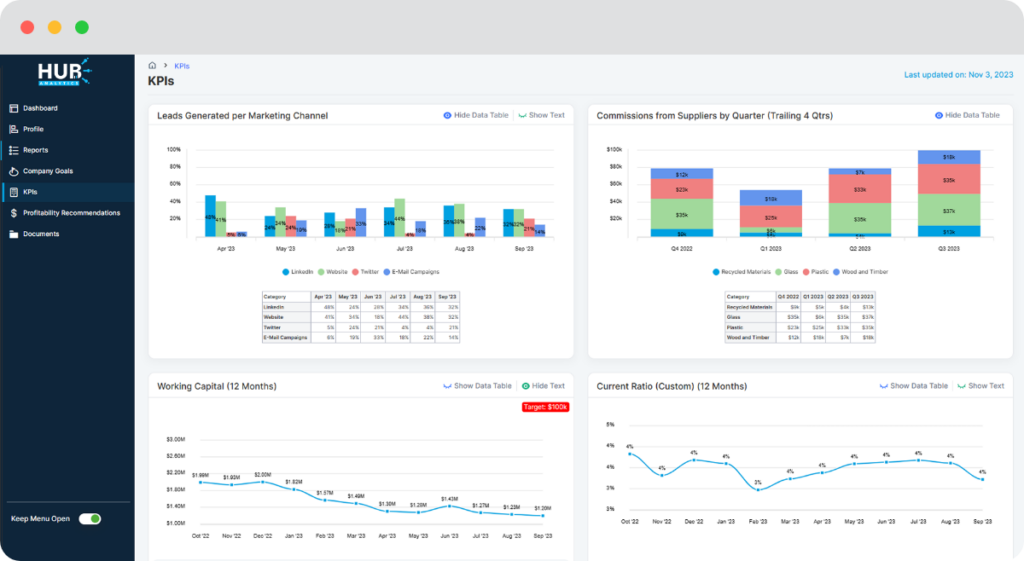This blog explores the significance of metrics, the specific ones tailored for professional services, and how to leverage them using HUB.
Metrics, or Key Performance Indicators (KPIs), are measurable values that gauge the performance and effectiveness of a business. In the realm of professional services, these metrics provide insights into various aspects of operations.
Metrics for professional services encompass indicators tailored to measure the unique nuances of service-based businesses. They delve into client satisfaction, project efficiency, and overall business performance.
Evaluate client contentment through surveys and feedback. A high CSI indicates satisfied clients, fostering loyalty and potential referrals, while a low score prompts proactive measures for improvement.
CSI = (Number of Satisfied Clients / Total Number of Clients) * 100
Assess the financial success of each project by comparing revenue generated against the costs incurred. This metric enables you to identify lucrative projects and allocate resources efficiently.
Project Profitability Ratio = Revenue Generated / Costs Incurred
Determine the efficiency of your team and resources by measuring the percentage of billable hours against total working hours. A higher utilization rate signifies optimal resource allocation and increased profitability.
Utilization Rate = (Billable Hours / Total Working Hours) * 100
Calculate the percentage of clients retained over a specific period, indicating the success of client relationship management. A high retention rate is a testament to client satisfaction and loyalty, reducing the need for extensive client acquisition efforts.
Client Retention Rate = (Number of Clients Retained / Total Number of Clients) * 100
Measure the average income generated per client. ARPU helps identify high-value clients, allowing you to focus on strategies that maximize revenue from existing clients and attract similar ones.
ARPU = Total Revenue / Number of Clients

Track the time spent on billable tasks within projects. This metric provides insights into workforce productivity and ensures accurate invoicing, optimizing revenue generation.
Billable Hours = Total Time Spent on Billable Tasks
Evaluate project delivery timelines against initial estimates. Monitoring timeline adherence helps identify potential delays, enabling timely interventions and maintaining client trust.
Measure team morale and engagement through employee satisfaction surveys. A high satisfaction score correlates with increased productivity, creativity, and employee retention.
Analyze the cost of acquiring new clients, including marketing, sales, and other associated expenses. Understanding CAC helps optimize acquisition strategies for a better return on investment.
CAC = Total Costs for Acquiring Customers / Number of New Customers Acquired

Calculate the profitability of investments made in marketing, technology, or training. A positive ROI indicates successful investments, while a negative ROI prompts a reevaluation of the allocated resources.
ROI = (Net Profit from Investment / Cost of Investment) * 100
Evaluate the efficiency of task execution within projects. A high task completion rate indicates effective project management, contributing to overall project success.
Task Completion Rate = (Number of Completed Tasks / Total Number of Tasks) * 100
Measure the productivity of your workforce by assessing how effectively employees utilize their time. This metric helps identify areas for improvement and optimal resource allocation.
Determine the long-term value of a client to your business by analyzing their historical spending patterns. CLV guides strategic decisions, ensuring efforts are directed towards clients with higher lifetime value.
CLV = (Average Annual Revenue per Customer * Average Customer Lifespan)
Assess the accuracy of deliverables by tracking the error rate. Monitoring and minimizing errors enhance service quality, customer satisfaction, and overall project success.
Error Rate = (Number of Errors / Total Number of Deliverables) * 100
Track the percentage increase in overall revenue over a specified period. A positive revenue growth rate indicates business success and effective implementation of growth strategies.
Revenue Growth Rate = ((Total Revenue in Current Period – Total Revenue in Previous Period) / Total Revenue in Previous Period) * 100
Selecting the right metrics is crucial. Tailor them to align with your business goals, ensuring a clear understanding of performance and areas needing improvement.
HUB provides a comprehensive platform for tracking and analyzing key metrics for professional services. Implementing HUB streamlines the process, offering real-time insights and facilitating data-driven decision-making.